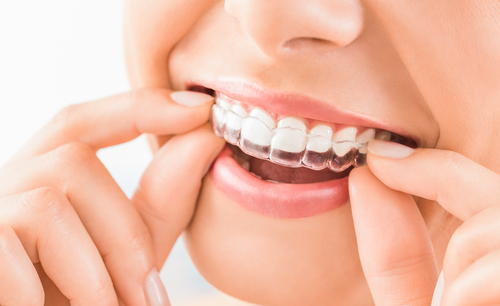Veneers are thin layers of tooth-colored material put on top of the front teeth to make them look whiter. This is a cosmetic procedure done by dentists and dental hygienists over at Smile Lab – Soho. Veneers can also be used to correct a variety of imperfections, such as crooked or misshapen teeth, stained or broken enamel, and chips in the tooth’s surface. Although veneers are typically permanent, they can be removed by your dentist if bonded incorrectly or they don’t provide the desired aesthetic results.

Who are veneers for?
Veneers are suitable for people with healthy teeth who want to improve the way other people perceive their smile. Veneers are a good choice for individuals who have severely stained teeth, fractured or chipped teeth, large gaps between their teeth, crooked or misshapen upper and lower jaw, crooked bite, misaligned upper and lower jaws (malocclusion), or facial asymmetry that makes the teeth appear uneven.
Benefits of veneers
Below are a few of the many benefits that veneers can provide:
- Restore the appearance of a beautiful smile.
The outer layer of the tooth, called enamel, is the most visible portion of the tooth. This hard and white layer provides an attractive appearance to a smile. When teeth are stained or chipped, however, their appearance can significantly be affected. Veneers can mask these imperfections by providing a smooth surface that is shaped and colored to look like healthy natural teeth.
- Make your teeth appear longer and straighter.
Veneers are thin layers of material bonded to the fronts of teeth in order to cover discoloration and/or reshape them into a more desirable form (e.g., aligned or thinner). The fact that veneers are typically thin and decorative make them appear longer, thinner, and straighter than the tooth directly below.
- Improve facial symmetry.
Although it is natural for misalignment to occur in the structure of a person’s face (e.g., face down look), it can be corrected with veneers if necessary. When teeth are chipped or stained, their shape is not typically symmetrical across the front of the mouth when viewed from above or below (i.e., when looking at your teeth from straight on). Veneers can be used to reshape crooked teeth into a symmetrical appearance that makes them appear even and attractive when viewed from both above and below.
- Maintain a beautiful smile after braces.
Veneers are used to cover off-colored or chipped front teeth when a person’s teeth are being straightened using braces. After receiving braces, many people are concerned about how their appearance will be affected and whether or not veneers can help them achieve the same aesthetic results as they did with their old, straighter teeth. Veneers can be used to hide chips and even restore the look of broken or stained teeth in some cases. Veneers can also provide a more uniform look when a person in braces has uneven tooth alignment (malocclusion).
- Maintain a beautiful smile after Invisalign treatment.
Invisalign is a popular alternative to metal braces that straightens teeth without being noticeable by others. Because it’s removable, however, the aligners are not as permanent as braces and may not be a good choice for adults who want to make their teeth appear more attractive and aligned. Veneers can provide the appearance of straight teeth and improve facial symmetry once Invisalign is removed or once it has been determined that teeth are not suited for the Invisalign system.
- Boost your self-confidence.
Many people believe that having a beautiful smile is a key to boosting one’s self-confidence, giving them the courage to climb a career ladder or gain social acceptance, while making them appear younger and more attractive.
- Preserve healthy teeth.
Because veneers are designed to cover the front of your teeth, they protect your gums and tooth structure from decay and make it less likely that you will lose healthy teeth due to gum disease. In addition, veneers may reduce pain caused by tooth sensitivity because they cover the portion of the tooth most prone to sensitivity (i.e., exposed root).
- Prevent further tooth damage.
The main benefit to placing veneers over chipped or fractured teeth is that they will help prevent further damage from occurring. With a veneer, the underlying tooth is protected from any additional wear and tear. If left unprotected, the remaining natural tooth can more easily chip or break if brushed too vigorously or improperly aligned.
Conclusion
If you’re unhappy with your smile, veneers may provide you with a better alternative than getting braces. Braces can straighten teeth and improve the appearance of your smile but they are not always aesthetically pleasing or discreet. Veneers have been proven to provide an attractive yet natural-looking alternative to metal braces that many people prefer.